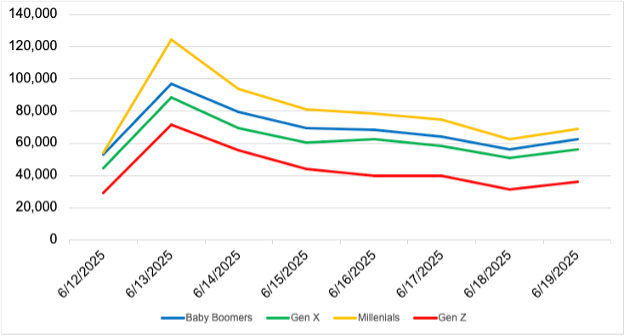This week, two Israeli embassy employees were fatally shot outside the Jewish Museum in Washington, D.C., where an event hosted by the American Jewish Committee (AJC) was taking place. The assailant, a Chicago native, was arrested at the scene and was filmed shouting “Free, free Palestine” as he was taken into custody. The incident prompted a wide range of reactions across social media platforms, including expressions of sympathy, political commentary, and, in some cases, antisemitic rhetoric and conspiracy theories around claims of a false flag attack.
Initial social media comments focused on reporting of the incident, as well as an outpouring of outrage, support, and condemnation of the act of hate. We tracked over 320,000 social media posts from over 112,000 people using words such as “devastated,” “heartbroken,” and “condemn” when speaking of the tragic murder of Yaron Lischinsky and Sarah Milgrim.
From Mourning to Misinformation: The Rise in False Flag Claims
However, as the news circulated more widely, social media conversations quickly expanded to include inflammatory narratives justifying the violence and framing the victims as political targets, rather than civilians. Users argued the victims were representatives of the Israeli government due to their roles at the embassy, suggesting their murders were a form of political retribution. However, this framing rests on a false premise, as the assailant targeted individuals attending the event at the museum and was likely not aware of the victims’ diplomatic affiliations at the time of the attack.
Other users took a step further, claiming the shooting was staged to garner support for Jews and justify Israel’s war against Hamas. The term “false flag” began trending across social media; the Command Center registered a 637% increase in the use of the term in the day following the event. Furthermore, the phrase was the sixth most used phrase in social media discussions about antisemitism since the murders.
The Persistence of False Flag Conspiracy Theories in Antisemitic Narratives
False flag conspiracy theories have long played a role in antisemitic discourse, often suggesting that Jews or Israel orchestrate violent events to manipulate public opinion or achieve political goals. This conspiracy theory has been used many times in history including in violent attacks such as 9/11, the Tree of Life Synagogue shooting in 2018, and the October 7th Hamas attack in 2023. These narratives draw on a broader antisemitic trope that portrays Jews as deceptive and manipulative, frequently accusing them of staging crises to control media narratives or influence foreign policy.

Mentions of “false flag” typically surge online following major events, such as the October 7 Hamas attack and, most recently, the shooting of two Israeli embassy employees in Washington, D.C. / Source: FCAS Command Center
These false flag narratives were amplified not only by anonymous fringe accounts, but also by some conspiracy figures with large followings, who used coded language or rhetorical questions to cast doubt on the legitimacy of the incident. For example, one user wrote “Is this a coincidence that this attack happened as the world wakes up to Israel’s evil?”
This pattern mirrors a broader trend in which antisemitic conspiracy theories are repackaged through the language of skepticism (e.g.,“I’m just asking questions” or opposing Israeli policy)—blurring the line between political critique and hate speech, resulting in discourse that both minimizes real violence against Jews and reinforces long-standing antisemitic myths about control, manipulation, and victimhood.
Amid the conspiracy theories and inflammatory rhetoric, many users reacted to the attack by pointing to the broader rise in antisemitism, especially over the past 18 months, as critical context. People on social media emphasized that the incident did not occur in a vacuum, but rather against a backdrop of escalating threats, harassment, and violence targeting Jewish individuals and institutions. Several commentators noted that the normalization of anti-Israel and antisemitic language online and offline—especially in the wake of recent geopolitical tensions—has created an environment in which such acts of violence feel increasingly foreseeable.
This incident, and the discourse that followed, reflect how quickly antisemitic narratives can take hold in the wake of violence. What begins as a tragedy is often reshaped through misinformation and hate, distorting public understanding and further endangering the communities most affected.






